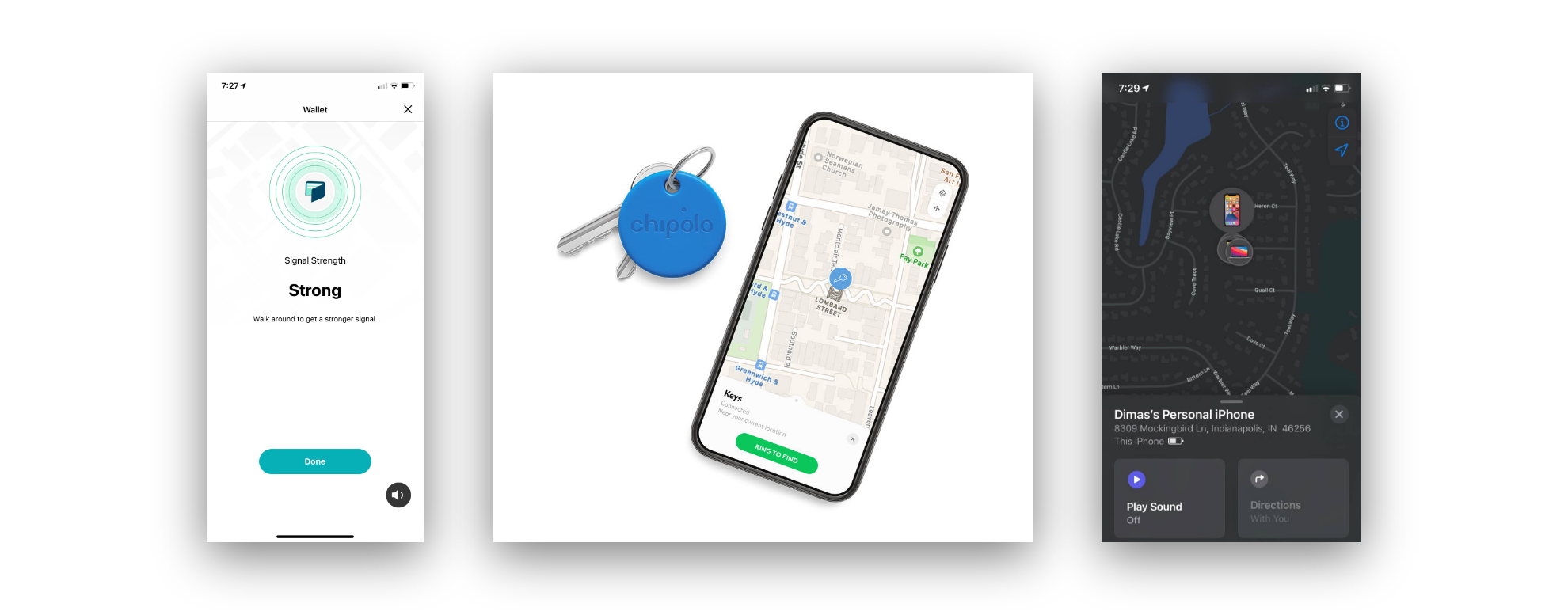Milwaukee Tool
Find Item
When Location History released for One-Key in 2020, one of its benefits was powerfully conveying where equipment is located outside of Bluetooth range (approximately 100 feet for One-Key tools). However, finding tools that are relatively close-by within 100 feet, say on a construction site or somewhere in your house, has needed improvement since the app’s inception. When Find Item released in mid-June 2021, it became easier for users to identify One-Key tools that are close to them in Bluetooth range.
MY ROLE
Concepting, developing research plan, leading design
DURATION
Late 2020 – June 2021
Understanding the previous solution
Previously, One-Key tools could only be identified close-by with the blink of a strong LED light for several seconds. This solution meets users’ needs when the environment is dark enough where a light is noticeable, or if multiple of the same tool are standing side-by-side and the user needs to identify a specify one. However, in real world scenarios where tools are often out of sight or the light is covered, simply blinking a light isn’t enough for many casual power tool users and crib managers.
Previous method for identifying One-Key tools
Initial problem solving
Work on Find Item was initially coupled to the One-Key Bluetooth Tracking Tag (Tracking Tag) that was eventually released in 2022 as a follow-up to Milwaukee Tool’s TICK Tool and Equipment Tracker (TICK). One of the improvements to its predecessor included better Bluetooth fidelity, speaker functionality, and an accelerometer.
Early One-Key Bluetooth Tracking Tag promotional image
In late 2020, once hardware engineering finalized the functionality of the Tracking Tag and informed my product partners in One-Key, I workshopped with my team how to best leverage the improvements from the TICK. Naturally, this led to ideation on how to improve the tracking experience when it came to items closer to you versus further away where Location History would step in.
Miro workshop on brainstorming uses in One-Key for the Tracking Tag
I analyzed competitors such as Tile and similar tracking solutions from Chipolo and Apple to better position the Tracking Tag. Where other items lacked and Find-Item provided was the ability to remain within the context of the One-Key app without having to switch between One-Key, Tile, Chipolo or Find My.
Competitor analysis of Tile (left), Chipolo (center), and Find My pre-Air Tag (right)
In addition, I mapped out the holistic Find Item experience, sketched ideas, and designed mockups to be tested within Milwaukee Tool due to confidentiality constraints.
Workflow for one scenario where a foreman using Find Item could locate an item on the jobsite
Select sketches ideating on what Find Item could look like
Sketching and concepting
When Find Item was decoupled from the Tracking Tag after realizing the feature could be abstracting to any item that had Bluetooth (all One-Key tools), the design at the time measured signal strength in 3 concentric rings. Although they gave visibility into how strong the connection was between the One-Key tool the user is searching for and their phone, testing showed that 3 levels of granularity didn’t respond well enough to movement.
Eventually, a prototype was created by my team’s iOS developer that showed the raw Bluetooth strength in the form of a bar gauge and when testing with 6 users indicated that it was referred to more than the concentric circles, I returned to square one.
Gauge design considerations using different shapes. A trapezoidal gauge was decided on due to its lesser and higher values being able to communicate the best out of the other shapes as well as its technical feasibility.
Different gauge shape considerations at high fidelity. I gave rectangular gauges another shot, but they were interpreted too much as a loading bar
Different color considerations for the Bluetooth signal gauge
Find Item
Find Item launched for One-Key 8.10 for iOS and Android in June 2021. User testing was conducted internally using a test version and results saw that the feature could still operate in a Bluetooth signal-heavy environment reminiscent of a job site with many Bluetooth emitting tools.
Find Item for iOS and Android
Left: Screen capture of the iPhone using Find Item on the right | Right: iPhone using Find Item to locate a One-Key tool approximately 80 feet away
Disconnection messages for iOS and Android. This message is only triggered when users either move outside of Bluetooth range or the item is not receiving enough battery power
Learn and ship
After Find Item launched in June 2021, the feature was monitored against internally defined metrics to understand how often people were using it to find equipment and the frequency of disconnections. Additionally, external channels One-Key were monitored such as customer reviews and business communications to see how Find Item is used on actual job sites, an environment I couldn’t test adequately due to COVID restrictions at the time.












